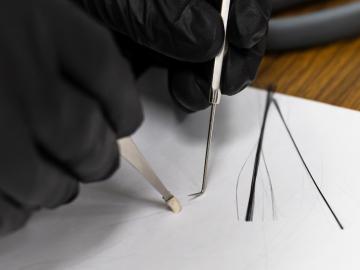
Filter News
Area of Research
- Advanced Manufacturing (7)
- Biology and Environment (5)
- Energy Science (19)
- Fusion and Fission (17)
- Fusion Energy (13)
- Isotopes (19)
- Materials (39)
- Materials for Computing (8)
- National Security (1)
- Neutron Science (8)
- Nuclear Science and Technology (17)
- Nuclear Systems Modeling, Simulation and Validation (1)
- Supercomputing (24)
News Type
News Topics
- (-) Advanced Reactors (25)
- (-) Frontier (45)
- (-) Fusion (47)
- (-) Isotopes (38)
- (-) Materials (87)
- 3-D Printing/Advanced Manufacturing (89)
- Artificial Intelligence (92)
- Big Data (62)
- Bioenergy (84)
- Biology (100)
- Biomedical (53)
- Biotechnology (28)
- Buildings (50)
- Chemical Sciences (48)
- Clean Water (30)
- Composites (21)
- Computer Science (153)
- Coronavirus (30)
- Critical Materials (17)
- Cybersecurity (17)
- Education (2)
- Emergency (4)
- Energy Storage (64)
- Environment (164)
- Exascale Computing (52)
- Fossil Energy (7)
- Grid (54)
- High-Performance Computing (93)
- Hydropower (12)
- Irradiation (2)
- ITER (7)
- Machine Learning (51)
- Materials Science (89)
- Mathematics (11)
- Mercury (10)
- Microelectronics (3)
- Microscopy (34)
- Molten Salt (7)
- Nanotechnology (29)
- National Security (63)
- Neutron Science (109)
- Nuclear Energy (85)
- Partnerships (37)
- Physics (38)
- Polymers (18)
- Quantum Computing (39)
- Quantum Science (58)
- Security (17)
- Simulation (51)
- Software (1)
- Space Exploration (23)
- Statistics (3)
- Summit (48)
- Transportation (66)
Media Contacts

Stronger than steel and lighter than aluminum, carbon fiber is a staple in aerospace and high-performance vehicles — and now, scientists at ORNL have found a way to make it even stronger.

As the focus on energy resiliency and competitiveness increases, the development of advanced materials for next-generation, commercial fusion reactors is gaining attention. A recent paper examines a promising candidate for these reactors: ultra-high-temperature ceramics, or UHTCs.

ORNL researchers helped introduce college students to quantum computing for the first time during the 2025 Winter Classic Invitational, providing hands-on access to real quantum hardware and training future high-performance computing users through a unique challenge that bridged classical and quantum technologies.
Troy Carter, director of the Fusion Energy Division at Oak Ridge National Laboratory, leads efforts to make fusion energy a reality, overseeing key projects like MPEX and fostering public-private collaborations in fusion research.

Researchers from ORNL have developed a new application to increase efficiency in memory systems for high performance computing. Rather than allow data to bog down traditional memory systems in supercomputers and impact performance, the team from ORNL, along with researchers from the University of Tennessee, Knoxville, created a framework to manage data more efficiently with memory systems that employ more complex structures.

US ITER has completed delivery of all components for the support structure of the central solenoid, the 60-foot-tall superconducting magnet that is the “heart” of the ITER fusion machine.

Researchers at Georgia State University used the Summit supercomputer to study an elaborate molecular pathway called nucleotide excision repair. Decoding NER’s sophisticated sequence of events and the role of PInC in the pathway could provide key insights into developing novel treatments and preventing conditions that lead to premature aging and certain types of cancer.

During his first visit to Oak Ridge National Laboratory, Energy Secretary Chris Wright compared the urgency of the Lab’s World War II beginnings to today’s global race to lead in artificial intelligence, calling for a “Manhattan Project 2.”

A workshop led by scientists at ORNL sketched a road map toward a longtime goal: development of autonomous, or self-driving, next-generation research laboratories.

Neus Domingo Marimon, leader of the Functional Atomic Force Microscopy group at the Center for Nanophase Materials Sciences of ORNL, has been elevated to senior member of the Institute of Electrical and Electronics Engineers.


